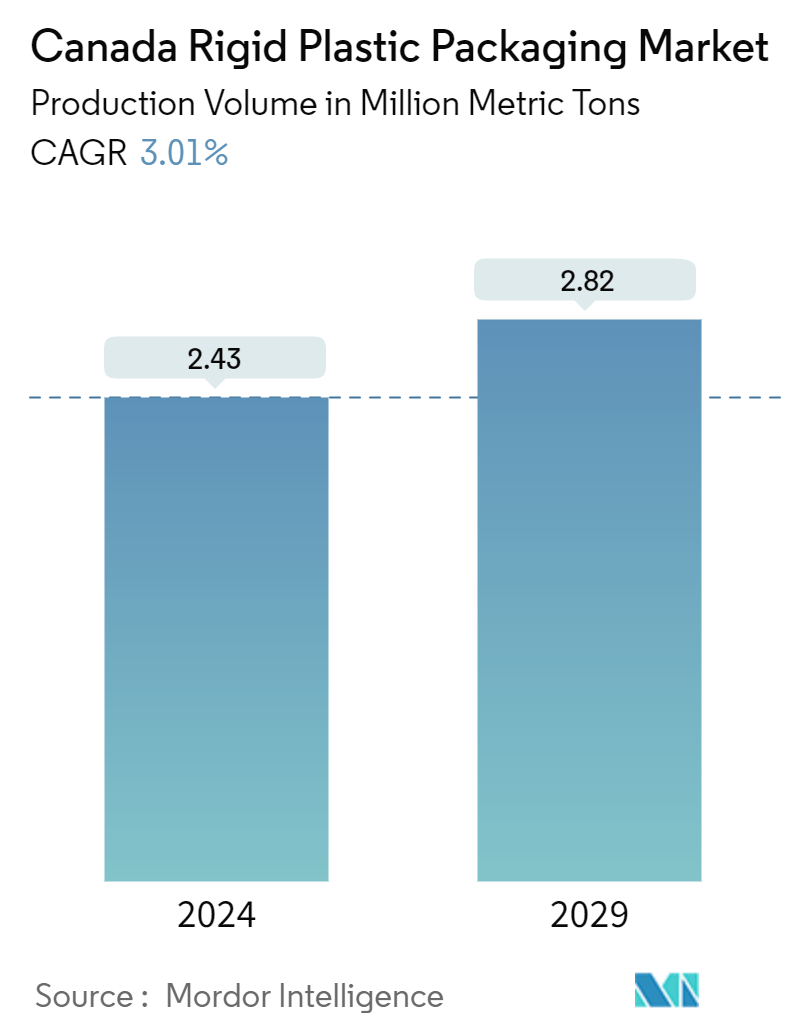Market Size of Canada Rigid Plastic Packaging Industry

| Study Period | 2019 - 2029 |
| Base Year For Estimation | 2023 |
| Market Volume (2024) | 2.43 Million metric tons |
| Market Volume (2029) | 2.82 Million metric tons |
| CAGR (2024 - 2029) | 3.01 % |
| Market Concentration | Low |
Major Players
*Disclaimer: Major Players sorted in no particular order |
Canada Rigid Plastic Packaging Market Analysis
The Canada Rigid Plastic Packaging Market size in terms of production volume is expected to grow from 2.43 Million metric tons in 2024 to 2.82 Million metric tons by 2029, at a CAGR of 3.01% during the forecast period (2024-2029).
- In Canada, the rigid plastic packaging market is significantly influenced by materials like polyethene (PE), polypropylene (PP), polyethene terephthalate (PET), and polystyrene (PS). Demographic trends in Canada, especially in urban centers like Toronto, Vancouver, and Montreal, are shaping the rigid plastic packaging landscape. As the urban population grows, so does the demand for convenient and portable packaging solutions, particularly in the beverage and personal care sectors. This is evident in the rising consumption of bottled water and beverages, driven by a health-conscious consumer base. Moreover, there's a noticeable shift toward premium and sustainable packaging in the personal care and cosmetics realm. Brands are innovating in rigid plastic packaging, striving for a blend of functionality, visual appeal, and environmental responsibility.
- Sustainability remains a cornerstone of Canada's rigid plastic packaging market. In April 2024, the Canadian government unveiled a comprehensive strategy aimed at curbing plastic pollution. This initiative seeks to enhance the entire lifecycle management of plastics, steering the nation toward a circular economy. In April 2024, an information-gathering notice was released under the Canadian Environmental Protection Act, 1999 (CEPA). This move is part of the Federal Plastics Registry initiative, which mandates companies, from resin manufacturers to plastic product producers, to provide annual reports. These reports will detail the types and quantities of plastics they manufacture, import, and market. Furthermore, producers and service providers must account for the lifecycle of plastics, including metrics on collection, diversion, reuse, recycling, and disposal methods.
- Aligning with the sustainability trend, many manufacturers are creating win-win situations across their value chains. Method, since its inception, has championed sustainability, especially in its innovative packaging. In a notable move, Method is crafting all its clear plastic bottles from recycled coastal plastic. This initiative is a result of a collaboration between SC Johnson and Plastic Bank. Their partnership has impressively recovered enough material to equal 3 billion bottles, repurposed into consumer product packaging. Canadian consumers can find Method's popular products, such as gel hand wash and laundry detergent, made entirely from these 100% recycled coastal plastic bottles.
- In January 2024, the Circular Innovation Council, a non-profit organization, unveiled a pioneering reuse program aimed at tackling single-use plastic waste in Canada. Developed in collaboration with major grocery retailers like Metro, Sobeys, and Walmart Canada and backed by the Government of Canada, this initiative is touted as the country's first. Set to start in mid-2024, the program will debut a reusable food container pilot in Ottawa. During this pilot, consumers can buy select food items in reusable containers at no extra charge from participating grocery and food service outlets.

